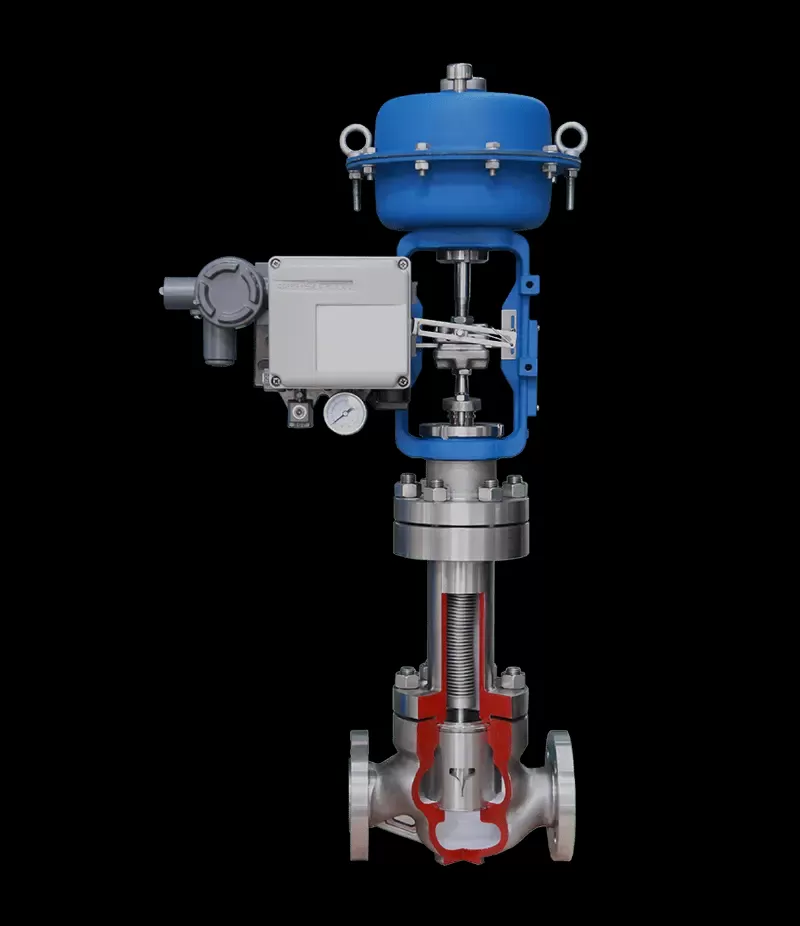Notifications

7 minutes, 12 seconds
-81 Views 0 Comments 0 Likes 0 Reviews

In industries where safety, environmental protection, and process reliability are paramount, even the smallest leaks can have serious consequences. Whether in petrochemical plants, pharmaceutical manufacturing, power generation, or semiconductor processing, stringent compliance with safety and emission standards is essential. In such demanding environments, bellows globe control valves have emerged as a vital solution, offering precise control with zero-emission performance.
A Bellows Globe Control Valve is an advanced variation of the conventional globe valve, distinguished by its integrated metallic bellows seal. This flexible seal ensures a hermetic barrier around the valve stem, effectively eliminating fugitive emissions, enhancing sealing integrity, and improving the valve’s handling of hazardous or volatile fluids. Beyond preventing stem leakage, the bellows design contributes to longer service life and reduced maintenance demands.
This article delves into the design, features, benefits, applications, and technical aspects of bellows globe control valves, highlighting their crucial role in safe and efficient industrial operations.
A bellows globe control valve is a linear motion valve engineered for high-precision fluid flow regulation in pipeline systems. Unlike standard globe valves, it features a metallic bellows element positioned between the valve body and stem. This bellows flexes with stem movement, isolating process fluids from the external environment and eliminating leakage risks typically associated with packing glands.
Constructed from corrosion-resistant stainless steel or similar alloys, the bellows is housed inside the bonnet and welded to both the stem and bonnet. As the stem moves to regulate flow, the bellows expands or compresses, maintaining a sealed barrier even under high pressure, aggressive chemicals, or elevated temperatures.
Traditional globe valves rely on packing around the stem to prevent leakage. However, packing materials degrade over time—especially under thermal cycling, vibration, or corrosive conditions—leading to fugitive emissions.
Bellows-sealed valves replace packing with a metallic bellows seal, offering key advantages:
Hermetic Sealing: Completely prevents leakage, meeting strict regulatory standards such as TA-Luft, ISO 15848, and EPA.
Low Maintenance: Eliminates frequent packing adjustments or replacements, reducing labor and downtime.
Extended Service Life: Bellows assemblies are durable, rated for tens of thousands of full-stroke cycles.
Enhanced Safety: Crucial when handling hazardous, flammable, or toxic fluids.
Metallic Bellows Assembly: Thin-walled stainless steel or Inconel bellows, helium leak-tested to ensure absolute sealing integrity.
Non-Rotating Stem Design: Prevents torsional stress on the bellows, improving stability and alignment.
Hermetically Welded Connections: Minimizes or eliminates threaded/flanged joints in sealing areas, removing potential leak paths.
Vacuum Brazed or Welded Seat: Permanently joins the seat to the valve body, eliminating loosening and leaks common in threaded seats.
Backup Packing Seal: Provides secondary sealing in case of bellows failure, often with leak detection ports for real-time monitoring.
Named after its globe-shaped body, this valve modulates flow by precisely positioning a plug or disc against a stationary seat. Main components include:
Valve Body: Pressure-retaining shell with inlet/outlet ports.
Bonnet: Houses stem and bellows, allowing maintenance access.
Valve Stem: Connects to actuator or handwheel, moving the plug.
Plug (Disc): Controls fluid throttling or shutoff.
Seat Ring: Sealing surface for the plug.
Bellows Seal: Welded to stem and bonnet, preventing leaks along the stem path.
Packing and Gland Assembly: Secondary seal backup.
Typically, these valves are automated via pneumatic, electric, or hydraulic actuators.
The valve’s internal trim heavily influences performance. Cage-type trims are common, providing:
Cage Guidance: Keeps the plug aligned during operation.
Replaceable Trim: Allows flow characteristic changes or noise reduction upgrades.
Anti-Cavitation Design: Minimizes cavitation damage under high differential pressures.
Noise Control Options: Reduces noise in gas or steam applications.
Combining bellows sealing with advanced trim designs ensures precise control, extended life, and improved safety.
Zero Leakage Guarantee: Helium-tested to leakage rates as low as 10⁻⁶ mbar·l/s, eliminating fugitive emissions.
Regulatory Compliance: Meets EPA, ISO 15848, TA-Luft, and similar standards.
Lower Maintenance: No frequent repacking or seal replacement needed.
Durability: Bellows withstand 20,000–50,000 full strokes, resist corrosion and fatigue.
Enhanced Process Control: Precise throttling with low hysteresis and fast response.
Versatility: Suitable for liquids, gases, vapors, and slurries across broad pressure and temperature ranges.
Petrochemical & Chemical Processing: Control of corrosive, acidic, or toxic fluids.
Power Generation: Boiler feedwater and steam regulation.
Pharmaceutical & Food: Sterile, cleanroom fluid handling.
Semiconductor Manufacturing: Ultra-pure water and gas flow control, vacuum processes.
Nuclear Industry: Reactor coolant and high-integrity containment systems.
Cryogenic Systems: Handling liquid oxygen, nitrogen, helium, and cold-box applications.
The demand for safe, reliable, and leak-free valve technology continues to grow in modern industrial processes. Bellows globe control valves provide a superior solution where conventional valves fall short, especially in handling hazardous or environmentally sensitive fluids.
By integrating a metallic bellows seal with precision internal components, these valves offer robust, low-maintenance performance and assured leak-tight operation over extended service life. Whether in chemical plants, cleanrooms, nuclear facilities, or critical infrastructure, bellows globe control valves deliver unmatched confidence in process control and environmental protection.Learn more about Google SEO.

